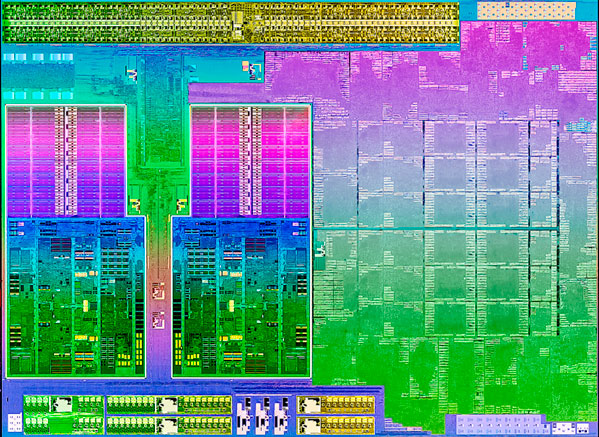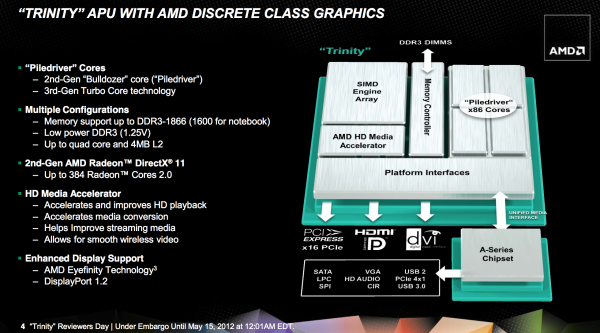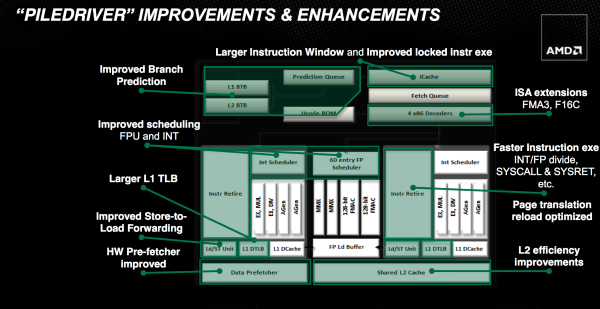The AMD Trinity Review (A10-4600M): A New Hope
by Jarred Walton on May 15, 2012 12:00 AM ESTIntroduction and Piledriver Overview
Brazos and Llano were both immensely successful parts for AMD. The company sold tons despite not delivering leading x86 performance. The success of these two APUs gave AMD a lot of internal confidence that it was possible to build something that didn't prioritize x86 performance but rather delivered a good balance of CPU and GPU performance.
AMD's commitment to the world was that we'd see annual updates to all of its product lines. Llano debuted last June, and today AMD gives us its successor: Trinity.
At a high level, Trinity combines 2-4 Piledriver x86 cores (1-2 Piledriver modules) with up to 384 VLIW4 Northern Islands generation Radeon cores on a single 32nm SOI die. The result is a 1.303B transistor chip (up from 1.178B in Llano) that measures 246mm^2 (compared to 228mm^2 in Llano).
| Trinity Physical Comparison | |||||
| Manufacturing Process | Die Size | Transistor Count | |||
| AMD Llano | 32nm | 228mm2 | 1.178B | ||
| AMD Trinity | 32nm | 246mm2 | 1.303B | ||
| Intel Sandy Bridge (4C) | 32nm | 216mm2 | 1.16B | ||
| Intel Ivy Bridge (4C) | 22nm | 160mm2 | 1.4B | ||
Without a change in manufacturing process, AMD is faced with the tough job of increasing performance without ballooning die size. Die size has only gone up by around 7%, but both CPU and GPU performance see double-digit increases over Llano. Power consumption is also improved over Llano, making Trinity a win across the board for AMD compared to its predecessor. If you liked Llano, you'll love Trinity.

The problem is what happens when you step outside of AMD's world. Llano had a difficult time competing with Sandy Bridge outside of GPU workloads. AMD's hope with Trinity is that its hardware improvements combined with more available OpenCL accelerated software will improve its standing vs. Ivy Bridge.
Piledriver: Bulldozer Tuned
While Llano featured as many as four 32nm x86 Stars cores, Trinity features up to two Piledriver modules. Given the not-so-great reception of Bulldozer late last year, we were worried about how a Bulldozer derivative would stack up in Trinity. I'm happy to say that Piledriver is a step forward from the CPU cores used in Llano, largely thanks to a bunch of clean up work from the Bulldozer foundation.
Piledriver picks up where Bulldozer left off. Its fundamental architecture remains completely unchanged, but rather improved in all areas. Piledriver is very much a second pass on the Bulldozer architecture, tidying everything up, capitalizing on low hanging fruit and significantly improving power efficiency. If you were hoping for an architectural reset with Piledriver, you will be disappointed. AMD is committed to Bulldozer and that's quite obvious if you look at Piledriver's high level block diagram:
Each Piledriver module is the same 2+1 INT/FP combination that we saw in Bulldozer. You get two integer cores, each with their own schedulers, L1 data caches, and execution units. Between the two is a shared floating point core that can handle instructions from one of two threads at a time. The single FP core shares the data caches of the dual integer cores.
Each module appears to the OS as two cores, however you don't have as many resources as you would from two traditional AMD cores. This table from our Bulldozer review highlights part of problem when looking at the front end:
| Front End Comparison | |||||
| AMD Phenom II | AMD FX | Intel Core i7 | |||
| Instruction Decode Width | 3-wide | 4-wide | 4-wide | ||
| Single Core Peak Decode Rate | 3 instructions | 4 instructions | 4 instructions | ||
| Dual Core Peak Decode Rate | 6 instructions | 4 instructions | 8 instructions | ||
| Quad Core Peak Decode Rate | 12 instructions | 8 instructions | 16 instructions | ||
| Six/Eight Core Peak Decode Rate | 18 instructions (6C) | 16 instructions | 24 instructions (6C) | ||
It's rare that you get anywhere near peak hardware utilization, so don't be too put off by these deltas, but it is a tradeoff that AMD made throughout Bulldozer. In general, AMD opted for better utilization of fewer resources (partially through increasing some data structures and other elements that feed execution units) vs. simply throwing more transistors at the problem. AMD also opted to reduce the ratio of integer to FP resources within the x86 portion of its architecture, clearly to support a move to the APU world where the GPU can be a provider of a significant amount of FP support. Piledriver doesn't fundamentally change any of these balances. The pipeline depth remains unchanged, as does the focus on pursuing higher frequencies.
Fundamental to Piledriver is a significant switch in the type of flip-flops used throughout the design. Flip-flops, or flops as they are commonly called, are simple pieces of logic that store some form of data or state. In a microprocessor they can be found in many places, including the start and end of a pipeline stage. Work is done prior to a flop and committed at the flop or array of flops. The output of these flops becomes the input to the next array of logic. Normally flops are hard edge elements—data is latched at the rising edge of the clock.
In very high frequency designs however, there can be a considerable amount of variability or jitter in the clock. You either have to spend a lot of time ensuring that your design can account for this jitter, or you can incorporate logic that's more tolerant of jitter. The former requires more effort, while the latter burns more power. Bulldozer opted for the latter.
In order to get Bulldozer to market as quickly as possible, after far too many delays, AMD opted to use soft edge flops quite often in the design. Soft edge flops are the opposite of their harder counterparts; they are designed to allow the clock signal to spill over the clock edge while still functioning. Piledriver on the other hand was the result of a systematic effort to swap in smaller, hard edge flops where there was timing margin in the design. The result is a tangible reduction in power consumption. Across the board there's a 10% reduction in dynamic power consumption compared to Bulldozer, and some workloads are apparently even pushing a 20% reduction in active power. Given Piledriver's role in Trinity, as a mostly mobile-focused product, this power reduction was well worth the effort.
At the front end, AMD put in additional work to improve IPC. The schedulers are now more aggressive about freeing up tokens. Similar to the soft vs. hard flip flop debate, it's always easier to be conservative when you retire an instruction from a queue. It eases verification as you don't have to be as concerned about conditions where you might accidentally overwrite an instruction too early. With the major effort of getting a brand new architecture off of the ground behind them, Piledriver's engineers could focus on greater refinement in the schedulers. The structures didn't get any bigger; AMD just now makes better use of them.
The execution units are also a bit beefier in Piledriver, but not by much. AMD claims significant improvements in floating point and integer divides, calls and returns. For client workloads these gains show minimal (sub 1%) improvements.
Prefetching and branch prediction are both significantly improved with Piledriver. Bulldozer did a simple sequential prefetch, while Piledriver can prefetch variable lengths of data and across page boundaries in the L1 (mainly a server workload benefit). In Bulldozer, if prefetched data wasn't used (incorrectly prefetched) it would clog up the cache as it would come in as the most recently accessed data. However if prefetched data isn't immediately used, it's likely it will never be used. Piledriver now immediately tags unused prefetched data as least-recently-used, allowing the cache controller to quickly evict it if the prefetch was incorrect.
Another change is that Piledriver includes a perceptron branch predictor that supplements the primary branch predictor in Bulldozer. The perceptron algorithm is a history based predictor that's better suited for predicting certain branches. It works in parallel with the old predictor and simply tags branches that it is known to be good at predicting. If the old predictor and the perceptron predictor disagree on a tagged branch, the perceptron's path is taken. Improving branch prediction accuracy is a challenge, but it's necessary in highly pipelined designs. These sorts of secondary predictors are a must as there's no one-size-fits-all when it comes to branch prediction.
Finally, Piledriver also adds new instructions to better align its ISA with Haswell: FMA3 and F16C.













271 Comments
View All Comments
medi01 - Thursday, May 17, 2012 - link
Half of CPU performance, but better GPU performance and power consumption.And I doubt that for an average consumer the first matters more than the latter.
wsaenotsock - Tuesday, May 15, 2012 - link
I mean to summarize all of this, it's a low performance processor with average graphics performance (comparing to an i7 and a discrete GPU), with above average battery life. I think with the right pricing AMD can put out a great rounded mobile product. The best thing it has going for it needs to be the price since it doesn't really lead the pack in any other area. I bought a Zacate netbook and I found it very useful for the price.I wonder if a few generations from now, AMD can begin to outperform CPU + discrete GPU's with it's combined APU chips, or at least on a per-watt basis really deliver uncomparable performance. That would really make the AMD fusion platform a new beast but it doesn't seem ready for that yet. Still it must be a goal for AMD and it is really one that will become more important as time goes on with computing solutions miniaturizing every year.
Denithor - Tuesday, May 15, 2012 - link
They won't ever surpass CPU + discrete GPU for one simple reason: TDP.You simply cannot match the performance of a 75-100W CPU + 100-200W GPU with a 75-100W APU.
Kaggy - Tuesday, May 15, 2012 - link
Any chance of Windows 8 comparison someday, just curious.Kaggy - Tuesday, May 15, 2012 - link
i meant processor comparison on windows 8EyelessBlond - Tuesday, May 15, 2012 - link
I'm wondering how the memory clocks are affecting Trinity performance. We saw with Llano that the processor was memory constrained, such that you saw a significant improvement with DDR3 1866 as opposed to DDR3 1600; now that the chip is shuffling bits even faster I'm curious to see if more memory throughput (triple channel DDR3, the new DDR4, or even a relatively simple memory overclock) can boost APU performance even more with these new chips.JarredWalton - Tuesday, May 15, 2012 - link
Officially, mobile Trinity only supports up to DDR3-1600, which is what we have for testing. The clocks on the desktop version will likely be higher, making more bandwidth potentially useful, but unfortunately we can't test anything higher than DDR3-1600 on Trinity. And as an aside, I tried using DDR3-1600 with the Llano laptop, only to find that the BIOS won't allow anything higher than DDR3-1333 speeds. I wouldn't be surprised if this prototype Trinity laptop is the same way with regards to RAM speeds -- the BIOS on this sort of laptop is always pretty bare.Khato - Tuesday, May 15, 2012 - link
Does the prototype Trinity laptop BIOS support running the memory at DDR3-1333? That would at least offer an indication of whether certain benchmarks are memory bandwidth limited or not which would then imply whether or not higher memory frequency actually would help. Would also be interesting to see performance with just single channel memory seeing as how all too many manufacturers are still shipping laptops with that configuration.JarredWalton - Tuesday, May 15, 2012 - link
I don't think so, but I can always stick in DDR3-1333 RAM if needed. Might be interesting, but you'll have to wait a day or two for me to get something like that tested.Khato - Tuesday, May 15, 2012 - link
Good idea, so long as it doesn't either overclock the memory to 1600 anyway or simply refuse to boot, haha. Hopefully it'll work though since I'm quite curious to see the results! It'll not only give us an idea of whether higher speed memory will help, but also how much of a hit the lesser versions of the iGPU on the other SKUs will take.